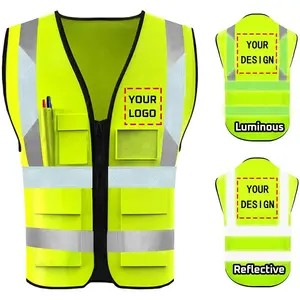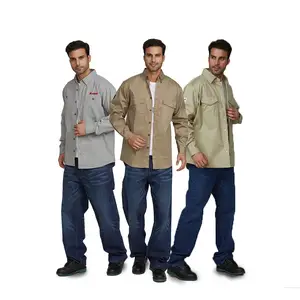Exploring Construction Worker Attire
Attire for construction workers spans a broad spectrum of protective wear and accessories, tailored for the building industry's professionals. These items are meticulously crafted to safeguard the well-being and enhance the comfort of laborers amidst construction endeavors. Emphasizing resilience, practicality, and adherence to safety protocols, this clothing aims to reduce the perils of physical threats, adverse weather, and exposure to chemicals or machinery.
Forged from sturdy substances capable of enduring the demands of physical toil, construction attire incorporates heavy-duty textiles, reflective details for heightened visibility, and occasionally, cutting-edge technology for superior performance. Its wearers range from on-site laborers to supervisors and safety officers, all of whom require compliance with safety mandates. The design of such apparel often features elements of conspicuousness, robustness, and regulatory conformity, ensuring the workforce is equipped with the necessary protective gear.
The practicality of construction attire is paramount for the workers' safety and productivity. It must permit unrestricted movement, enabling tasks involving bending, lifting, and scaling heights. Moreover, attributes like water resistance and thermal insulation are essential for defense against the elements. For example, those in damp or frigid settings may need attire that repels water and retains heat.
Varieties of Construction Worker Attire
Diverse forms of construction attire cater to distinct environmental conditions and occupational needs. Notable varieties include:
-
High-Visibility Apparel: Crucial for those needing to stand out in dim lighting or bustling areas, this clothing typically features luminous hues such as orange or yellow, complemented by reflective strips or patches.
-
Fire-Resistant Apparel: In scenarios with potential fire hazards or sparks, like welding or grinding tasks, fire-resistant clothing is indispensable. These garments may be crafted from materials like aramid fibers or specially treated cotton to shield from heat and flame.
-
Insulated Apparel: To combat the cold or fluctuating temperatures on-site, insulated workwear provides warmth while maintaining visibility and safety characteristics.
-
Waterproof and Breathable Gear: For outdoor labor in wet conditions, waterproof yet breathable fabrics are key, keeping moisture out while allowing perspiration to escape, thus ensuring a comfortable work setting.
-
Anti-Static Apparel: To safeguard workers and delicate equipment from static discharge, anti-static wear is employed, featuring special textiles or finishes that dissipate static away from the body.
-
Quick-Dry and Moisture-Wicking Apparel: In hot or humid climates, quick-drying and moisture-wicking fabrics help maintain a cool and dry state by swiftly transporting sweat from the skin for evaporation.
-
Lightweight and Breathable Gear: In warmer conditions or when less cumbersome protection is adequate, lightweight and breathable materials offer comfort without sacrificing safety or visibility.
Selecting Construction Worker Attire
Choosing the right construction attire necessitates a thorough evaluation of the hazards present at a worksite. Employers should consider:
-
Material: Fabric selection should align with the job's nature. For instance, 100% cotton may be favored for its breathability in hot climates, whereas a polyester blend could provide greater resilience.
-
Features: Certain jobs may require specialized features like high-visibility colors for traffic safety, fire-resistant qualities for flame-involved work, or waterproofing for outdoor tasks. Recognizing these needs is key to informed decision-making.
-
Comfort: Given the extended wear time, comfort is essential. Elements such as elastic fabrics or adjustable waistbands can enhance fit and lessen weariness.
-
Size and Fit: Correct sizing is critical for comfort and safety. Providing a spectrum of sizes ensures suitable fits for all workers.
Companies should also weigh factors like seasonal demands (insulation for winter attire), style preferences (one-piece versus two-piece outfits), and compliance with sector-specific rules (e.g., high-visibility requirements).
About Construction Worker Attire on Alibaba.com
Alibaba.com distinguishes itself as a premier international marketplace, offering a vast array of construction worker attire to meet diverse occupational needs. Since 1999, the platform has bridged buyers with global suppliers, presenting an unmatched selection that addresses the full gamut of construction tasks, accommodating various regions and climates. From robust multifunctional jackets with visibility features to specialized knee pads for added safety, Alibaba.com caters to every project specification.
A cornerstone of Alibaba.com is its dedication to streamlining transactions between enterprises. The platform's intuitive interface enables direct communication and negotiation between buyers and suppliers, tailoring terms to their unique requirements. Furthermore, Alibaba.com's Trade Assurance service adds a layer of confidence by safeguarding payments until order fulfillment is verified.
For firms intent on equipping their construction teams with dependable attire that meets safety standards without compromising quality or functionality, Alibaba.com is an essential tool. Its extensive product range across various categories simplifies the search for job-specific attire, offering advantages like waterproofing, breathability, and an ample selection of sizes and hues for any professional construction setting.
Common FAQs for Construction Worker Attire
What materials are commonly used for construction worker attire?
Construction worker attire is predominantly crafted from resilient materials like polyester and cotton blends, with high-visibility variants for safety and regulatory compliance.
How can I ensure the construction worker attire I purchase is compliant with safety standards?
To guarantee compliance with safety standards when acquiring construction worker attire, ensure the products conform to relevant certifications. Requesting documentation from suppliers to affirm compliance may be advantageous.
Are there waterproof options available in construction worker attire?
Indeed, waterproof and water-resistant attire is available in materials such as PVC, polyester with PU coating, and rubberized textiles, offering moisture protection.
What features should I look for in high-visibility construction worker attire?
High-visibility attire should incorporate retro-reflective stripes, striking color contrasts for various backgrounds, and adherence to pertinent safety standards.
Can I find flame-resistant construction worker attire?
Flame-resistant attire is accessible and particularly vital for workers in settings with potential exposure to open flames or sparks.
Is it possible to get customized construction worker attire?
Many suppliers provide OEM and ODM services, enabling customization of construction worker attire with company branding, specific color schemes, or distinctive design features.
What is the benefit of choosing anti-static construction worker attire?
Anti-static features are advantageous in environments where static sparks could ignite or cause explosions. Such attire mitigates this hazard.
How do I choose the right size range when ordering construction worker attire?
Account for your workforce's demographics and opt for a broad size range to accommodate all. Some items may come in 'one-size-fits-all' or 'free size' for simplified procurement.
What is the importance of layering with construction worker attire?
Layering offers extra protection and insulation against environmental risks. For example, donning a base layer of flame-resistant material beneath a reflective vest adds an additional safeguard against flames.
Can I find durable yet comfortable construction worker attire options?
Certainly, material advancements have led to the creation of attire that is both robust and comfortable. Seek options with reinforced seams and premium fabrics.
Are there specific color requirements for construction worker attire?
While standard colors for construction attire include orange, yellow, or red, some projects may necessitate specific hues to align with company safety protocols or local mandates.
What does 'free size' mean in the context of construction worker attire?
'Free size' generally denotes garments designed to fit a broad array of body shapes comfortably, obviating the need for extensive custom fitting or alterations.
How does seasonality affect the choice of construction worker attire?
Construction attire should be seasonally appropriate, with lighter, airier options for summer and layered pieces for the colder months.
What should I consider when selecting the fabric type for construction worker attire?
When choosing fabric for construction attire, consider the working environment—light and breathable textiles are ideal for hot climates, while tougher materials like twill or canvas may be better for more severe conditions.
How does gender specification affect the choice of construction worker attire?
Gender-specific designs ensure that the attire fits correctly and is suitable for the wearer. It's crucial to select options that provide comfort and meet safety standards while accommodating the different physiques of men and women.











































 浙公网安备 33010002000092号
浙公网安备 33010002000092号 浙B2-20120091-4
浙B2-20120091-4